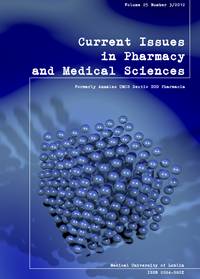Concentration of isoprostanes as a marker reflecting oxidative status in moderate dyslipidemia
DOI:
https://doi.org/10.12923/j.2084-980X/25.3/a.01Keywords:
dyslipidemia, HDL, oxidative stress, isoprostanes (F2-IsoP)Abstract
Dyslipidemia and oxidative stress are considered one of the major causes which lead to many diseases, especially atherosclerosis development, cardiovascular disorders and aggravate risk for cancers, aging and others. Lipid hydroperoxides are the initial products when lipids are damaged by free radicals and in plasma HDL is their major carrier. F2-IsoP are stable compounds and specific products of lipid peroxidation only in phospholipids in vivo through nonenzymatic free-radical mechanisms. Also, they are found in detectable quantities esterified in all biological tissues and in free form in all normal biological fluids. Quantifying of them is considered as accurate way to measure oxidative stress in vivo and could be used as an indicator of lipid peroxidation which process is a risk factor for atherosclerosis and other systemic diseases. Our study was performed in the group of young people (n=10, age 19-30) with moderate dyslipidemia and the reference group. In both groups we have investigated serum lipids (TG, TC, LDL-C, HDL-C, nonHDL-C), lipoproteins (apoAI, apoB) and lipid (TC/HDL-C, TG/HDL-C, LDL-C/HDL-C) and lipoprotein (HDL-C/apoAI) ratios and oxidative status by measuring free and total (free and esterified) F2-isoprostanes (F2-IsoP). According to the available data reports and taking into account results obtained in our study we concluded that even mild lipid and lipoprotein abnormalities which are often present in population might by connected with elevated oxidative status which is sensitively reflected by F2-IsoP concentration. Thus measurement of F2-IsoP seems to be very helpful in recognition of early stage of oxidative stress however further studies are required.
References
1. Ahotupa M., Suomela J.P., Vuorimaa T. et al.: Lipoprotein-specific transport of circulating lipid peroxides. Ann. Med., 42(7),521, 2010.
2. Basu S.: Measurement of F2-Isopropstanes in Tissues and Biological Fluids as an in Vivo Index of Oxidative Stress. Methods in Redox Signaling, 31, 2010.
3. Bowry V.W., Stanley K.K. Stocker R.: High density lipoprotein is the major carrier of lipid hydroperoxides in human blood plasma from fasting donors. Proc. Natl. Acad. Sci., 89(21), 10316, 1992.
4. Delample D., Durand F., Severac A. et al.: Implication of xanthine oxidase in muscle oxidative stress in COPD patients. Free Radic. Res., 42(9), 807, 2008.
5. Garza C.A., Montori V.M., McConnell J.P. et al.: Association between lipoprotein-associated phospholipase A2 and cardiovascular disease: a systematic review. Mayo Clin. Proc., 82(2), 159, 2007.
6. Hałabiś M., Kimak E., Baranowicz-Gąszczyk I. et al.: Lipid and lipoprotein status in hemodialysed patients. Annales UMCS Sect. DDD, XXIII, 2, 131, 2010.
7. Kimak E., Hałabiś M., Baranowicz-Gąszczyk I.: Association between moderately oxidized low-density lipoprotein and high-density lipoprotein particle subclass distribution in hemodialyzed and post-renal transplant patients. J Zhejiang Univ. Sci. B, 12,5, 365, 2011.
8. Mackness B., Hine D., Liu Y. et al.: Paraoxonase 1 inhibits oxidized LDL-induced MCP-1 production by endothelial cells. Biochem. Biophys. Res. Commun., 318, 680, 2004.
9. Montuschi P., Barnes P., Roberts LJ.: Insights into oxidative stress: the isoprostanes. Current Med. Chem., 14, 703, 2007.
10. Montuschi P., Nair U., Niki E. et al: Comprehensive Invited Review F2-Isoprostanes in Human Health and Diseases: From Molecular Mechanisms to Clinical Implications. Antioxid. Redox Signal., 10, 1405, 2008.
11. Nikolaidis M.G., Kyparos A., Vrabas I.S.: F2-isoprostane formation, measurement and interpretation: The role of exercise. Prog. Lipid Res., 50, 89, 2011.
12. Proudfoot J.M., Barden A.E., Loke W.M. et al.: HDL is the major lipoprotein carrier of plasma F2-isoprostanes. J Lipid Res., 50(4), 716, 2009.
13. Raven O.I., Pinchuk E., Schnitzer M. et al.: Kinetic analysis of copper-induced peroxidation of HDL, autoaccelereted and tocopherol-mediated peroxidation. Free Radic. Biol. Med., 29(2), 131, 2000.
14. Roberts L.J., Morrow J.D.: Measurement of F2-isoprostanes as an index of oxidative stress in vivo. Free Radic. Biol. Med., 28(4), 505, 2000.
15. Salahudeen A.K., Oliver B., Bower J.D. et al.: Increase in plasma esterified F2-isoprostanes following intravenous iron infusion in patients on hemodialysis. Kidney Int., 60(4), 1525, 2001.
16. Shao B., Heinecke J.W.: HDL, lipid oxidation, and atherosclerosis. J Lipid Res., 50, 599, 2009.
17. Shuhei N., Söderlund S., Jauhiainen M. et al.: Effect of HDL composition and particle size on the resistance of HDL to the oxidation. Lipids Health Dis., 9, 104, 2010.
18. Sodergen E., Cederberg J., Vessby B. et al.: Vitamin E reduces lipid peroxidation in experimental hepatotoxicity in rats. Eur. J Nutr., 40(1), 10, 2001.
19. Stafforini D.M., Sheller J.R., Blackwell T.S. et al.: Release of Free F2-isoprostanes from Esterified Phospholipids Is Catalyzed by Intracellular and Plasma Platelet-activating Factor Acetylhydrolases. J Biol. Chem., 281(8), 4616, 2006.
20. Subbanagounder G., Wong J.W., Lee H. et al.: Epoxyisoprostane and epoxycyclopentenone phospholipids regulate monocyte chemotactic protein-1 and interleukin-8 synthesis. Formation of these oxidized phospholipids in response to interleukin-1beta. J Biol. Chem., 277, 7271, 2002.
Downloads
Published
Issue
Section
License
Copyright (c) 2012 Authors

This work is licensed under a Creative Commons Attribution-NonCommercial-NoDerivatives 3.0 Unported License.


